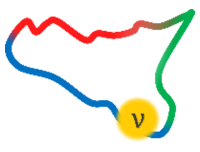Speaker
Description
The high momentum transfer encountered in heavy ion Double Charge Exchange (DCE) reactions provides an ideal environment for studying correlation phenomena beyond mean-field in Nuclear Matrix Elements (NMEs). This investigation is of paramount interest for probing the nuclear counterpart of the elusive neutrinoless double beta (0νββ) decay. Currently, the NMEs for such a decay are embedded in a complex puzzle due to the large uncertainty in their determination [1]. Knowing with high precision the NMEs, the neutrino Majorana mass might be determined, provided the 0νββ lifetimes [2]. In this respect, the NUMEN [3] project aims to study a wide range of heavy-ion induced DCE reactions in order to provide constraints in the calculation of the NMEs [2].
The DCE reaction is mainly fed through three main competitive processes, namely multi-nucleon Transfer Double Charge Exchange (TDCE) [4], the Double Single Charge Exchange (DSCE) [5] and the Majorana Double Charge Exchange (MDCE) [6]. The latter is a meson exchange process mediated by an effective rank-2 isotensor interaction, coming from the off-shell pion-nucleon DCE scattering. It presents a pronounced short-range character, ranging from the dimension of about 1 fm. Microscopic calculations of MDCE-NMEs have been performed, where the pion potentials play the role of the strong interaction counterparts to the 0νββ neutrino potentials. The strong short-range correlations induced by the pion potentials leading to a new type of two-body transition form factors, which are of central importance and highest interest for nuclear spectroscopy.
The multipole structure of pion potentials and NMEs will be discussed, focusing on the importance and features of the pion potentials.
References
[1] M. Agostini et al., Rev. Mod. Phys 95, 025002 (2023).
[2] F. Cappuzzello et al., Prog. Part. Nucl. Phys. 128, 103999 (2023).
[3] F. Cappuzzello et al., EPJ A 54, 72 (2018).
[4] J. L. Ferreira et al., PRC 105, 014630 (2022).
[5] J. I. Bellone et al., Phys. Lett. B 807, 135528 (2020).
[6] H. Lenske et al., Universe 10, 202 (2024).

